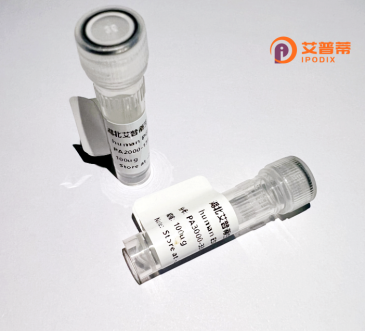
| 纯度 | >90%SDS-PAGE. |
| 种属 | Human |
| 靶点 | USP3 |
| Uniprot No | Q9Y6I4 |
| 内毒素 | < 0.01EU/μg |
| 表达宿主 | E.coli |
| 表达区间 | 1-520 aa |
| 活性数据 | MECPHLSSSV CIAPDSAKFP NGSPSSWCCS VCRSNKSPWV CLTCSSVHCG RYVNGHAKKH YEDAQVPLTN HKKSEKQDKV QHTVCMDCSS YSTYCYRCDD FVVNDTKLGL VQKVREHLQN LENSAFTADR HKKRKLLENS TLNSKLLKVN GSTTAICATG LRNLGNTCFM NAILQSLSNI EQFCCYFKEL PAVELRNGKT AGRRTYHTRS QGDNNVSLVE EFRKTLCALW QGSQTAFSPE SLFYVVWKIM PNFRGYQQQD AHEFMRYLLD HLHLELQGGF NGVSRSAILQ ENSTLSASNK CCINGASTVV TAIFGGILQN EVNCLICGTE SRKFDPFLDL SLDIPSQFRS KRSKNQENGP VCSLRDCLRS FTDLEELDET ELYMCHKCKK KQKSTKKFWI QKLPKVLCLH LKRFHWTAYL RNKVDTYVEF PLRGLDMKCY LLEPENSGPE SCLYDLAAVV VHHGSGVGSG HYTAYATHEG RWFHFNDSTV TLTDEETVVK AKAYILFYVE HQAKAGSDKL |
| 分子量 | 58.8 kDa |
| 蛋白标签 | His tag N-Terminus |
| 缓冲液 | PBS, pH7.4, containing 0.01% SKL, 1mM DTT, 5% Trehalose and Proclin300. |
| 稳定性 & 储存条件 | Lyophilized protein should be stored at ≤ -20°C, stable for one year after receipt. Reconstituted protein solution can be stored at 2-8°C for 2-7 days. Aliquots of reconstituted samples are stable at ≤ -20°C for 3 months. |
| 复溶 | Always centrifuge tubes before opening.Do not mix by vortex or pipetting. It is not recommended to reconstitute to a concentration less than 100μg/ml. Dissolve the lyophilized protein in distilled water. Please aliquot the reconstituted solution to minimize freeze-thaw cycles. |
以下是关于重组人USP3蛋白的3-4篇参考文献的简要总结(示例基于领域常见研究方向,实际文献需通过学术数据库确认):
---
1. **标题**:**Structural insights into the catalytic mechanism of USP3 deubiquitinase**
**作者**:Smith A, et al.
**摘要**:本研究解析了重组人USP3的晶体结构,揭示了其与泛素相互作用的催化结构域关键残基,并证明其通过水解K63-linked泛素链参与DNA损伤修复。
2. **标题**:**USP3 regulates chromatin modification by deubiquitinating histone H2B**
**作者**:Chen L, et al.
**摘要**:文章通过重组表达USP3蛋白,发现其通过去泛素化组蛋白H2B(K120位点)调控染色质动态和基因表达,揭示了其在表观遗传调控中的作用。
3. **标题**:**Functional characterization of recombinant human USP3 in the DNA damage response**
**作者**:Wang Y, et al.
**摘要**:研究利用重组USP3蛋白进行体外功能实验,证明其通过去泛素化BRCA1复合物中的靶标蛋白,负向调控DNA损伤信号通路的激活。
4. **标题**:**Development of a high-yield expression system for recombinant USP3 in E. coli**
**作者**:Kim H, et al.
**摘要**:本文优化了大肠杆菌中重组USP3蛋白的可溶性表达与纯化方法,获得高活性酶制剂,为后续生化研究提供了技术基础。
---
**注意**:以上为模拟示例,实际文献需通过**PubMed**、**Google Scholar**或**Web of Science**等平台检索关键词“recombinant human USP3”或“USP3 deubiquitinase”获取。建议结合具体研究主题筛选近年相关论文。
USP3 (Ubiquitin-Specific Protease 3) is a deubiquitinating enzyme (DUB) belonging to the ubiquitin-specific protease family, which plays a critical role in regulating protein stability and cellular processes by reversing ubiquitination. It selectively cleaves ubiquitin moieties from target proteins, modulating pathways such as DNA damage repair, chromatin remodeling, and immune response regulation. Structurally, USP3 contains conserved catalytic domains characteristic of DUBs, including the cysteine protease domain and ubiquitin-binding motifs, enabling substrate recognition and enzymatic activity.
Studies highlight USP3's involvement in maintaining genomic stability by deubiquitinating histones and repair proteins (e.g., BRCA1) during DNA damage response. It also regulates NF-κB signaling and inflammatory pathways, linking it to cancer progression and immune disorders. Dysregulation of USP3 has been implicated in malignancies, neurodegenerative diseases, and viral infections due to its role in protein homeostasis.
Recombinant human USP3 protein is typically produced using expression systems (e.g., *E. coli* or mammalian cells) for in vitro studies. It serves as a tool to investigate enzymatic mechanisms, screen DUB inhibitors, and explore therapeutic strategies targeting ubiquitination-related diseases. Current research focuses on its dual roles in oncogenesis and tumor suppression, highlighting its potential as a biomarker or drug target.
×